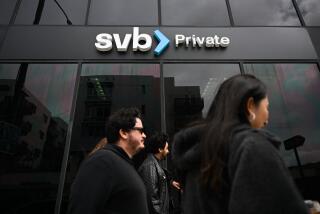How to Get Health Report on Bank
- Share via
QUESTION: You recently did a column about insurance on bank deposits that indicated as an aside that there is a list of troubled institutions kept by federal regulators. What a useful source of information that would be for all of us worried about the condition of our banks. How do I obtain a copy?--A. Y.
ANSWER: You can’t. Giving out that information is illegal. So not even congressmen, newspaper reporters and others who regularly deal with the regulators have access to it. There is, however, a way to make a pretty good guess about which banks and savings and loans are considered “troubled” and are under government scrutiny.
Simply get a copy of the latest financial statement for the bank or S&L; you’re concerned about. (The institution’s customer relations or community affairs departments should provide one to you at no cost.) Look for three numbers: assets, capital and retained earnings. If the bank’s current capital-to-assets ratio--that is, the sum of its capital and retained earnings divided by its assets--is below 6%, there’s a good bet that it’s on the troubled list.
Don’t jump to conclusions, though. Being on the troubled list doesn’t mean that the institution is on the brink of failure. It simply means that regulators are probably working with its executives and have given them a certain number of months to improve the health of their institution.
The Federal Deposit Insurance Corp., which regulates banks, does have an elaborate rating system that shows whether the bank’s condition is great, good, in need of watching, in bad trouble or doomed. The rating reflects such things as management competence, liquidity and strength of assets.
But, again, the regulators are forbidden to make this public. The most they can disclose is the number of U.S. banks in each category. That makes depositors mad, but you can understand why it’s the law. Rating a bank as likely to fail would surely cause a run and ensure its demise.
If you aren’t satisfied with the capital-to-assets rule of thumb, you have another, though much more costly, option. A number of companies--many founded by people who, like you, tired of being told they couldn’t get critical financial information--take the same information that is available to the regulators (known as call reports) and publish quarterly health reports. Anyone can buy this information.
The question is, how useful would you find it? Some of the reports are extremely difficult to wade through because they are intended for investment bankers and others whose living depends on being able to analyze a company’s health in great detail. But others are one-page overviews that purport to show in a glance whether you want your money in that bank, S&L; or credit union.
Those who regularly deal with financial institutions say the information is more detailed than most consumers need or want. The best barometer, they say, is simply to look for the FDIC or FSLIC insignia on the door of the bank or S&L; that you’re thinking of dealing with. If it’s insured--and your deposit falls within the federal insurance limit--you have nothing to worry about. If it isn’t, walk away. Other things to look for include changes in top management at the institution and large declines in year-to-year assets and deposits.
The companies that offer health reports say that while most of their clients are institutions, the number of individuals buying the reports has grown as deregulation has taken its toll on the staying power of financial institutions.
Two of the best are Veribanc in Woburn, Mass., and IDC Financial Publishing in Heartland, Wis. Both base their ratings on the call reports that institutions supply the government and update them quarterly.
Veribanc publishes about 30 reports, but there are four that individuals will find most useful. One, available for $20, is a basic financial overview of a specific bank, savings and loan or credit union that rates the relative strength of the institution to others in its industry. A second, which costs $45, does the same but provides more in-depth financial information. The third, available for $45, lists all U.S. banks losing money so rapidly that they would consume all of their equity within 12 months if the losses continued at the current rate. And the fourth, also costing $45, lists all U.S. banks whose level of problem loans exceeds the sum of their equity and loan-loss reserves.
While the presence of a bank on the latter list doesn’t ensure that it will fail, Veribanc says it has found that 90% of the institutions that eventually do fail had so many problem loans that the level exceeded the sum of their equity and loan-loss reserves.
IDC provides similar information from the same source but in a different package. It ranks all federally insured banks and savings and loans and publishes those rankings, along with pertinent financial information, in two large volumes that are updated quarterly. The savings and loan report is available for $299 a year. The bank report costs $499 yearly. You can subscribe to both for $698.
For more information about these reports, call IDC at (414) 367-6868 or Veribanc at (617) 245-8370.
Debra Whitefield cannot answer mail individually but will respond in this column to financial questions of general interest. Do not telephone. Write to Money Talk, Business section, The Times, Times Mirror Square, Los Angeles 90053.
More to Read
Inside the business of entertainment
The Wide Shot brings you news, analysis and insights on everything from streaming wars to production — and what it all means for the future.
You may occasionally receive promotional content from the Los Angeles Times.










